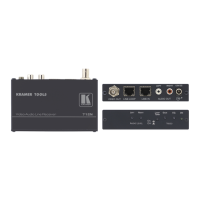Your Video-Audio Line Transmitter/Receiver
3
3.2 Shielded Twisted Pair (STP) / Unshielded Twisted Pair (UTP)
The decision whether to use shielded twisted pair (STP) cable or unshielded
twisted pair (UTP) cable depends on the nature of the application.
It is recommended that in applications with high interference, shielded twisted pair
(STP) cable is used. However, the shield itself does create a capacitance that
degrades the frequency response of the machines. For shorter distances, of 50m or
so, shielded twisted pair (STP) cable may be preferred because it provides better
protection from interference (degradation is non-apparent).
For a long-range application, unshielded twisted pair (UTP) cable is preferred.
However, the unshielded twisted pair (UTP) cable should be installed further
away from electric cables, motors etc., which are prone to create electrical
interference.
4 Your Video-Audio Line Transmitter/Receiver
This section defines the:
711N Video-Audio Line Transmitter (see section 4.1)
712N Video-Audio Line Receiver (see section 4.2)
4.1 Your 711N Video-Audio Line Transmitter
Figure 1, Figure 2 and Table 1 define the 711N Video-Audio Line Transmitter:

